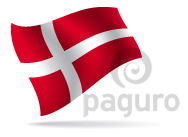About Denmark - facts, figures, sizes and systems
Kongeriget Danmark - The Kingdom of Denmark
Form of government: Constitutional monarchy
Capital: København (Copenhagen), 1.21 m inhabitants in the metropolitan area
Major cities: Århus (nearly 300,000), Odense (185,000), Aalborg (160,000)
Area: 43,098 km2 Flag: The flag is very important to the Danes and they will bring it out on any occasion worthy of celebration. You will find it on buses and everywhere on the Queen's birthday, on Christmas trees, on birthday cakes as well as at the airport, on the arrival of loved one, when family or friends pick up Danes returning from abroad.
Flag: The flag is very important to the Danes and they will bring it out on any occasion worthy of celebration. You will find it on buses and everywhere on the Queen's birthday, on Christmas trees, on birthday cakes as well as at the airport, on the arrival of loved one, when family or friends pick up Danes returning from abroad.
Population: 5.4 m inhabitants scattered over various islands. The mainland is the peninsula of Jutland, attached to Germany and crowned by some 443 named islands, only 76 of which are inhabited. The biggest island is Zeeland (Sjælland), where the capital, Copenhagen, is situated.
Population density: approx. 127 inhabitants per km2
Average life expectancy: men 75+ years, women 80+ years.
Language: Danish, one of the North Germanic languages. Danish and Swedish, derive from East-Nordic dialect group, while Norwegian is classified as a West-Nordic language together with Faroese and Icelandic.
Danish has many vowels – including the special letters æ, ø and å – and many significant glottal stops, which make it difficult for foreigners to learn Danish.
Despite the small size of the country there are dialects, accompanied by the inevitable character stereotypes – inward Jutlanders in the west, chatty Funen in the middle, to the Zealanders in the east with their broad and drawling dialect. The metropolitan population speaks a flat and rapid language, in line with the cities fast paced life.
Danes, Swedes and Norwegian languages are fairly close and those living near to the borders between two countries can understand each other easily.
Most Danes speak English or German, which they learn in school from the age of 10/11.
Religion: The official state religion in Denmark is the Evangelical Lutheran Church, and more than 80% is part of the National Lutheran Church, but in general the Danes are not practising religious people.
GDP per capita: $47,867
Currency: Danish krone (DKK). Although part of the European Union, Denmark negotiated special "opt-outs" from the Maastricht Treaty allowing the country to preserve the krone (Kroner is the plural) while most other members of the Union adopted the Euro in 1999.
Abbreviation: kr or DKK
Coins and banknotes come in the following denominations:
1krone =100øre.
Coins: 25øre (1/4 of a krone), 50øre (1/2 a krone) - 1kr, 2kr, 5kr, 10kr, 20kr
Banknotes: 50, 100, 200, 500, 1000 kr
Time zone: Standard time zone is GMT +1. In Denmark ‘summer time’ (Daylight Saving Time) is applied; clocks are put 1 hour forward from last Sunday of March till last Sunday of October.
Electricity: 220-240 volts, 50 Hertz. Plugs are two pronged, round ended, type C more commonly known as Europlug. This plug is unearthed.
Internet id: .dk
Telephone plugs: RJ11 is the telephone plug more and more used in Denmark. In older houses or apartments you can still find the traditional 3 pronged plug, but changing it to RJ11 is not a problem.
TV system: PAL B/G system, like most of Europe. It is possible to get video recorders that play both NTSC (for Japanese and American videos) and PAL.
DVD zone: 2
Measure system: metric.
Phone code: country code is +45.
When calling Denmark you dial:
international code of the country you are calling from +45+phone number.
Area codes are included in the phone numbers!
Calling from Denmark you dial:
00 (international code)+country code+phone number.
Mattress/bed sizes: Beds and mattresses are generally smaller than in the US.
Single(twin) beds are 90x200 cm
Queen Size 140 or 160x200 cm
King size: 180x200 cm
Danes love to sleep with duck down pillows and covers (Dyne in Danish) which are sold in single or double sizes; bed linen come accordingly.
Clothes sizes: In Denmark mostly standard European sizes are used for adult clothes but more and more you find US sizes as well as some individual country sizes on the tags.
Children sizes are indicated by age or by height (in cm) of the child.
Further reading
For anyone wishing to further their understanding and knowledge of Denmark we suggest as a further reading the Danish goverment brochure
